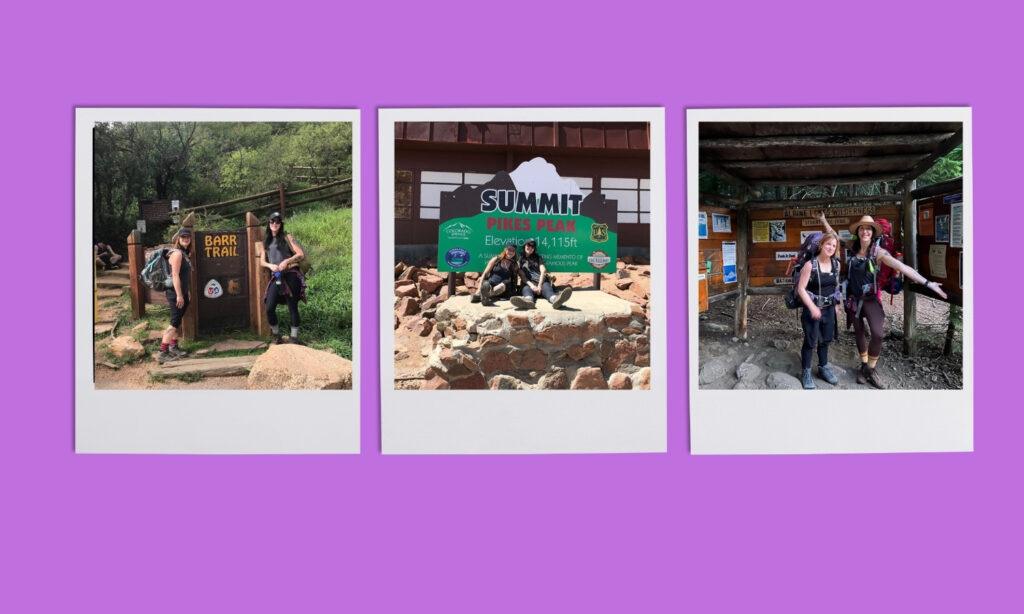Every summer, my best friend Monica and I plan an outdoor adventure. We live in different states and these trips have helped keep our friendship strong as our lives have changed. They’re the kind of adventures our partners tend to not want to join us on, and our other friends have by now learned better than to commit to them.
You see, we wake up before the sun and hike all day at altitudes we are not accustomed to, which can be as grueling as it is rewarding. We’ve summited three 14ers [peaks about 14,000 feet] in Colorado and, most recently, did a multi-day backpacking excursion in the Enchantments in Washington state. Each of these trips has had highs (literal ones — 14,000 feet is so high!) and real lows (like dragging a much too heavy backpack straight up a mountain for four hours).
It is daunting to plan a big backpacking or hiking trip, especially without a lot of experience. But I’ve found some great resources and I’ve learned quite a bit along the way (although I am still learning, too) that have helped me gain confidence as a burgeoning adventurer. I’ve outlined some of what I’ve discovered so far here, in a backpacking guide for beginners.

Choose Your Own Adventure
The first thing to do is to actually decide on a destination and, if applicable, your trip’s duration and route. This step requires some self-reflection and honesty. What are you prepared to do physically and mentally? What amount of adventure is actually appealing to you? What is your experience level and that of your companions? Are there local options that appeal to you or are you looking to travel?
It’s better to have a shorter adventure that leaves you wanting more than committing to something that will leave you tapped out and miserable. So be realistic about how much you can hike in a day, especially while wearing a heavy backpack, or whether you are comfortable on a hike that has no bathroom facilities and requires you to learn about backcountry hygiene. You may prefer what I sometimes refer to as adventure-lite, a trip that involves a camp area with bathrooms and other amenities. And that’s okay. But it’s important to discuss your comfort level with your companions so you can all be on the same page.
Monica and I had a great experience hiking Pike’s Peak in Colorado. It’s 14,115 feet up, and that elevation can be difficult for those coming from flat states. Even though the hike was difficult, though, being able to stay at Barr Camp halfway up made it much more accessible and comfortable.
Barr Camp has a toilet (albeit in an outhouse), a stream from which you can filter water, campsites or a bunk you can sleep in, and — most importantly — a spaghetti dinner each night and a pancake breakfast each morning that we still talk about four years later. This meant we only had to carry sleeping bags, which we could leave at the camp when we passed by on our way to the top.
Eliminating the need to carry a tent, sleeping pad, stove, meals, and their accompanying bear canister significantly lightened both our loads and the amount of planning we needed to do. I would highly recommend an experience like this as a first one. It allowed us to control for several variables, focus on the hike up the mountain and back down to camp (which was hard enough), and eat really delicious pancakes before we hiked out the following morning.
Find Your Adventure Buddies
If you have friends, a partner, or a family member who is willing and able to join you, great! But I can’t stress this enough: Make sure you communicate well and often about your wants, skill levels, and comfort levels.
At least one of your group members should be able to use every piece of gear you have confidently, and ideally, they have experience using them in an environment similar to the one you’ll face on your trip. Otherwise, you’ll have to practice assembling your tent, inflating and deflating your sleeping pads, etc.
Monica and I rented a stove from REI just before our last trip. It didn’t come with instructions and I couldn’t locate any for that particular model before we went. I haphazardly assembled it the night before our trip to test it out and thought we’d be fine. When dinner rolled around our first night, we thought the sound we heard when we turned the stove on was a good sign. It was actually the sound of our fuel draining. We ended up realizing our mistake in time to retain enough fuel to last our trip, but it could have resulted in very sad, cold dinners — or worse.
Depending on your experience, and the destination, you might consider joining a group or meet-up or a guided excursion. Send Femme is a paid membership group that offers education and organizes hiking and backpacking meetups exclusively for women (cis/non-cis) and gender minorities. REI also offers guided backpacking trips of varying lengths and difficulties for people of all skill sets. Meetup.com and Facebook have groups for hikers, backpackers, trail runners, and other adventure-lovers who organize all different kinds of excursions. These are great ways to meet like-minded people, to adventure safely, and to gain skills and confidence for your next trip.
The outdoor industry has inordinately represented white cis males, which has contributed to the creation of a variety of barriers for people from historically underrepresented groups. There are a number of organizations working toward diversifying the outdoors, helping people cross those barriers. One of them, the Inclusive Outdoors Project, hosts clinics and events that focus on accessibility, specifically geared toward BIPOC and queer communities.
Plan and Prepare
Getting into a sought-after park requires not only planning but, in some cases, quite a bit of luck. Many of the most popular natural areas require permits to backpack and camp overnight. We were fortunate to get permits to the Enchantments, which are notoriously difficult to obtain. There is an annual pre-season lottery from February to March, and additional spots open throughout the year. Recreation.gov is a good resource, listing many permit lotteries as well as local non-permitted campgrounds and hikes. AllTrails can also help you locate routes for hikes of all kinds in your area and elsewhere. Gaia also provides downloadable GPS maps for a fee.
Once you’ve set a place and time for your trip, you can start to read about the particularities of that place, plan the exact hiking route, and consult the internet to see if anyone has assembled a guide or packing list that matches your trip.
Get Educated
Something essential to know that a lot of backpacking guides neglect to include is the indigenous history of our public lands. Learning and acknowledging this history is an important part of being a good visitor to these places. You might also consider other ways to support the native communities who are near to or have been relocated from the ground you are treading. Our public land is full of natural wonder and wildlife that is important to respect and care for. It also has a human history we should honor.
Aside from backcountry hygiene and bathroom etiquette, you’ll also want to learn more about Leave No Trace principles to help preserve the land you are traversing, about the gear you are using, and about hiking etiquette, common safety concerns, and backcountry cooking. Read other hikers’ stories and suggestions about the exact place you’re visiting. I found a plethora of trip reports and packing lists for the Enchantments but, for less popular excursions, reviews on Alltrails are a great way to start, and there are many sample backpacking lists to draw from.
Being very type A, I took the lists I found and made them into a spreadsheet I shared with Monica, and we checked off our lists as we packed. This let us collaborate on our list and share ideas. We had a separate tab for planning our meals and snacks.
Of course, we packed entirely too much, even with all of our careful planning and after significantly culling our food pile. I would elect to leave the hardcover novel at home next time. I was too tired to read and my pack was much too heavy. I would, upon reflection, also pack a comb. All of our adventures are also learning experiences.
I recommend packing and weighing your bag before leaving, while also considering how much weight extra snacks and water will add. A full backpack should not exceed 20% of your body weight. If you can, practice a day hike or even a walk around your neighborhood with your pack at full weight.
Get Excited
Planning a big outdoor adventure can be daunting. There are so many details to consider. But it’s also exciting. As your trip approaches, communicate with your companions, read other trip reports online, and follow the social media feeds of people who have undertaken or are undertaking big adventures of their own.
Heather Anderson, the first woman to hike the Appalachian Trail, Pacific Crest Trail, and Continental Divide Trail (referred to as the triple crown) in just one year, is also a writer who shares her insights both in her book Thirst: 2600 Miles to Home; Mud, Rocks, Blazes: Letting Go on the Appalachian Trail and on social media.
Shilletha Curtis, who is planning her second Continental Divide Thru Hike and is also chasing the triple crown, writes about the experience of being a Black woman on the trail.
Women Who Hike highlights tips, stories, and achievements from women all over the world.
Have Fun
Finally, get outside and enjoy yourself, even if everything isn’t perfect. Enjoy how good a rehydrated freeze-dried meal can taste after you’ve carried it up a mountain. Enjoy your companions, the time away from the buzzing of your phone. Enjoy the birds or other wild creatures you might not see in other environments. Enjoy the sunrise and the sunset and the stars. With any luck, those beautiful moments will outweigh everything else — including your heavy backpack.


